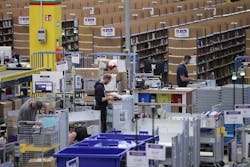To achieve a secure and efficient supply chain is the top goal for manufacturers, according to BDO USA, LLP. The group analyzed factors listed in the most recent 10-K filings of the largest 100 publicly traded U.S. manufacturers and 100% of manufacturers listed supply chain risk is a major concern. This number was up from 83% in 2013.
Manufacturers are increasingly concerned about forecasting errors which could lead to backlogs or shortages, as well as quality issues they may encounter with suppliers.
Moreover, 88% of manufacturers note risks related to natural disasters, which could cause transportation breakdowns and significant delays.
Significant concerns over additional exposures caused by the global nature of supply chains are fueling the reshoring trend in the manufacturing industry.
In addition to supply chain concerns, labor challenges present a challenge, according to the 2014 BDO Manufacturing RiskFactor Report. Manufacturers are contending with a number of U.S. labor challenges. In fact, labor was cited by 97% of manufacturers as a risk this year, up notably from 2013 (75%).
The manufacturing workforce is being squeezed as growth fuels more demand for workers and a greater number of baby boomers are retiring. Moreover, the skills gap among prospective workers is leaving available jobs unfilled.
“Growth in the economy and an increase in capital spending is excellent news for the manufacturing industry,” said Howard Sosoff, Manufacturing & Distribution practice leader at BDO USA, LLP. “But with greater opportunity comes greater challenges. Manufacturers will face intense competition this year as they work to attract new orders and workers and expand their capabilities.”
Further findings in the report:
Conflict Mineral Disclosure Drives Regulatory Risks. Manufacturers also report significant challenges when it comes to regulation. Nearly all (99%) cite federal state or local regulation as a risk factor and 87% note concern over accounting standards and regulations, up from 66% in 2013. Manufacturers point to the June 2nd deadline to file disclosures about the use of conflict minerals as a key compliance challenge which could prove costly to their business. In addition, an increased focus on internal controls by auditors and regulators is putting added pressure on manufacturers.
M&A Risks Rise Amid Increased Competition. Growth in the manufacturing industry is also leading to fierce competition for resources, workers and speed to market. Ninety-four percent of manufacturers cite competition and consolidation as a risk this year, and as seen by the recent Hillshire Farms and Pinnacle deal in the food processing industry, many are turning to acquisitions to gain an edge. More manufacturers (89%, up from 80% in 2013) cite risks related to mergers and acquisitions, a sign that many are looking outside their company to gain access to new technologies, IP, products and distribution channels to improve their market position.
IP Protection Heightens Data Security Risks. High profile data breaches have businesses in all industries on edge. According to Verizon, the manufacturing industry accounted for less than one percent of security incidents in 2013, but nearly one-in-four of those incidents involved data loss. While manufacturers store less consumer data than their customers in the retail industry, the protection of intellectual property is crucial, and any loss could threaten manufacturers’ ability to compete effectively. As a result, 78% of manufacturers cite risks related to data security this year, up from 64% in 2013. Moreover, the protection of intellectual property and rising concerns over security are also likely contributing to the increase in manufacturers citing litigation risks (79%, up from 57% in 2013).
About the Author

Adrienne Selko
Senior Editor - MH&L, IW, & EHS Today
Adrienne Selko has written about many topics over the 17 years she has been with Endeavor Business Media and currently focuses on workforce development strategies. Previously Adrienne was in corporate communications at a medical manufacturing company as well as a large regional bank.
She is the author of Do I Have to Wear Garlic Around My Neck? which made the Cleveland Plain Dealer's best sellers list. She is a senior editor at Material Handling & Logistics, EHS Today, and IndustryWeek.
Editorial Mission Statement:
Manufacturing is the enviable position of creating products, processes, and policies that solve the world’s problems. When the industry stepped up to manufacture what was necessary to combat the pandemic, it revealed its true nature. My goal is to showcase the sector’s ability to address a broad range of workforce issues including technology, training, diversity & inclusion, with a goal of enticing future generations to join this amazing sector.
Why I Find Manufacturing Interesting:
On my first day working for a company that made medical equipment such as MRIs, I toured the plant floor. On every wall was a photo of a person, mostly children. I asked my supervisor why this was the case and he said that the work we do at this company has saved these people’s lives. “We never forget how important our work is and everyone’s contribution to that.” From that moment on I was hooked on manufacturing.
I have talked with many people in this field who have transformed their own career development to assist others. For example, companies are hiring those with disabilities, those previously incarcerated, and other talent pools that have been underutilized. I have talked with leaders who have brought out the best in their workforce, as well as employees doing their best work while doing good for the world.
